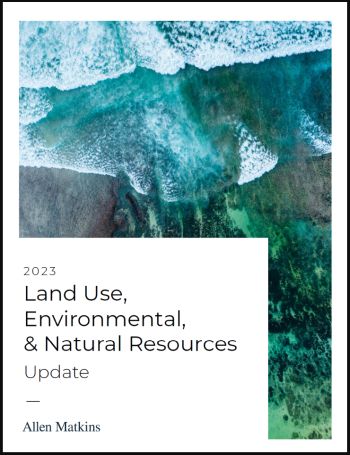How does California's drought — or on the other end of the spectrum, an overabundance of water — impact our economy, infrastructure, and real estate development? David Osias and Barry Epstein, both partners at the law firm Allen Matkins and thought leaders on water rights, land use, natural resources, and energy law, joined Jerry Nickelsburg, adjunct professor of economics at the UCLA Anderson School of Management, and Andrew Ayres, a research fellow at the Public Policy Institute of California Water Policy Center, to discuss water rights, the challenges of water distribution in California, legal issues, and possible solutions, as well as obstacles to the solutions.
WATER PROBLEMS IN CALIFORNIA — NOT A NEW STORY
It's not news that California suffered from a decades-long drought, the worst in over 1,000 years, immediately followed by a once-in-a-century winter snowpack and rainfall. Episodic droughts and floods have long been a part of the region's history, which is why the state's modern landscape reflects the efforts to manage both. Although California's average snowpack and rainfall suggest abundant supplies, where that precipitation occurs, its distance from population and farming centers, and the wide variation in volume from year to year make the "average" an unreliable predictor of water availability. 75% of California's precipitation falls north of Sacramento, while 80% of the state's water use is south of the city. In truth, a lot of precipitation falls on the state, but the annual water supply comes from about nine storms a year, with half falling between December and February. In other words, precipitation doesn't fall evenly throughout the state or the year, so there is usually too much or too little water at any given time. And there is almost no such thing as a "normal" year.
California's state and federal water projects are in place to move water to where it is needed and when it is needed. However, these projects were all built in the early-mid 1900s and weren't designed for today's circumstances, including global warming, significant population growth leading to greater water requirements, and the strain on the environment from increases in consumptive uses of water. Additionally, farming has changed, with a decrease in annual crops and an increase in more permanent crops like trees and vines, which make annual water supply fluctuations more difficult for farmers to adjust to.
WATER RIGHTS — A COMPLEX ISSUE
Water rights are incredibly complex, with different types of water rights having different priorities and other attributes that affect their allowed use, locations and transfers, all of which is beyond summarizing in a succinct fashion. However, in general, and without regard to a variety of exceptions to the rules affecting where water rights can be exercised and with what priority, the following fairly summarizes the status quo.
The water rights laws on the books in California make it extremely difficult to change the distribution of available supply, if desired, to meet competing needs. Priority of water rights is mainly determined by the historical date of acquisition of the right for stream systems and groundwater basins, but subject to the highest priority belonging to contiguous or overlying landowners. So contiguous/overlying rights and older (senior) rights have priority, and the higher priority rights are entitled to be satisfied in full before junior rights get any water. This hierarchy of water rights does not consider the modern societal or economic value of water, i.e., the importance of one use versus another.
Water rights are not only defined by who holds them, but also by where the water is taken from, where it can be used, and what it can be used for. So to repurpose water that is subject to a water right, changes may need to be made regarding where it's taken from, for what purpose, where it's used, or all of these. These changes may require state approval, and in general, they cannot cause injury to any other water rights holder. And, like most things involving water rights, what an injury is and whether one is caused is frequently a matter of dispute. Additionally, proposals of this sort often trigger an environmental review. And the delivery systems (canals, etc.) needed to move the water to a new destination may be owned by a third party. As a result, the transaction barriers to changing water rights and repurposing water use can be slow and expensive to overcome. Complicating the matter further, taking water from one area and using it in another can become a hot political issue.
In one instance, a large transaction to transfer conserved water supplies took five years to negotiate and document, and an additional nine years to resolve the lawsuits challenging the transfer. It eventually went through, but real estate developers are understandably hesitant when the issue of water rights could delay a project for years and add significantly to the overall cost.
THE REASONABLE AND BENEFICIAL USE DOCTRINE
Regarding water use, the Reasonable and Beneficial Use Doctrine included in the California Constitution is gaining more traction. Notwithstanding the priority system, state agencies are flexing their muscles a bit more when it comes to the "reasonable" part of this provision as a mechanism for requiring reductions in water use by senior water rights holders. There will likely be more regulations regarding reallocation and redistribution using this "reasonable" requirement. However, it's expected that this will be very controversial and highly litigated.
POSSIBLE SOLUTIONS
California's Pacific coast stretches for over 800 miles, and desalination of seawater has been proposed as a way to ameliorate the state's water shortage. But this method is expensive and difficult for at least four reasons:
- Desalination plants have to be built on the coast, which is among the most costly real estate in the country.
- The costs of building and operating a plant are high.
- The process has to be done in an environmentally benign way (e.g., preventing the capture of living organisms, preventing dead zones from discharge of brine or thermal pollution, etc.).
- The desalinated water is at sea level, and all the users are at a higher elevation, which presents additional energy costs for moving the water from the plant to the people.
Some proposed desalination plants were found lacking in sufficient protection of the environment. Plants that have been approved are dealing with disputes and disagreements over whether the approvals were correct.
Overall, desalination isn't the single silver bullet that will cure California's water shortage problem.
What about storage and more equitable distribution? Aside from the water rights issue mentioned above, more storage is needed to capture water when it is available. One problem is there isn't much land in flood plains that isn't already built on. While storage and distribution are feasible, the costs will be very high. Additionally, moving water from north to south means going through the Delta region, which is historically very litigious, and it could take years to sort through all the legal challenges that are likely to arise.
The experts all agree that California's water problem can be alleviated — through desalination, more storage and distribution, aggressive water conservation, and the use of recycled water. The technology is there. The main problem is money, as all these endeavors will cost a great deal.
The content of this article is intended to provide a general guide to the subject matter. Specialist advice should be sought about your specific circumstances.


